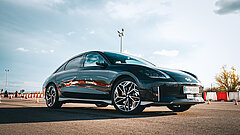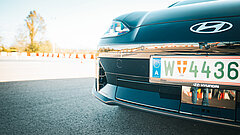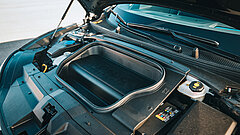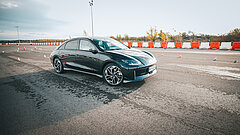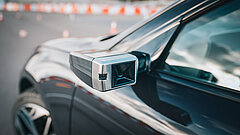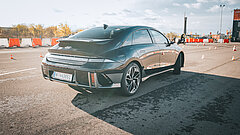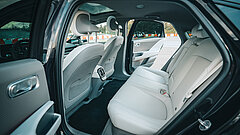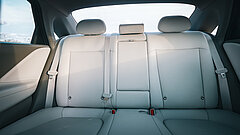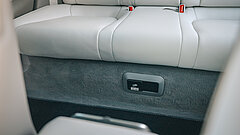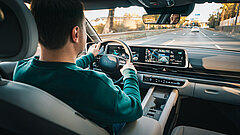Hyundai IONIQ 6 Review: Design, Charging & Operating
The Hyundai IONIQ 6 is the latest addition to the electric car lineup. Following the already extremely successful Hyundai IONIQ 5 SUV, it is the Korean brand's first fully electric mid-size saloon. This award-winning model has garnered attention for its dynamic performance, efficiency, and striking appearance. We couldn't resist the temptation to explore its features, as we had the opportunity to drive the Hyundai IONIQ 6 for five days.
In this article, we want to introduce you to the vehicle and share our impressions with you.
Do you want to allow Integration of youtube videos?
Allows the playback of videos, that are hosted on youtube.com. By allowing this feature, you accept the privacy agreement of google.
Brief overview of the Hyundai IONIQ 6
Hyundai Austria provided us with the Hyundai IONIQ 6 TOP LINE Long Range model with the exterior colour Biophilic Blue Pearl. The vehicle is equipped with a battery capacity of 77.4 kWh, delivers 239 kW or 325 hp on the road and costs around €76,800 including optional extras.
The basic version of the IONIQ 6 with a smaller battery is already available for less than €50,000 including the subsidy.
Exterior design: The body of the Hyundai IONIQ 6
The Hyundai IONIQ 6, in our case the 4WD version, i.e. with all-wheel drive, has a very distinctive appearance. Its streamlined silhouette with rounded lines simply stands out on the road. However, this "banana shape", as some call it, fulfils a purpose. It is designed to improve aerodynamics. And it does, because the Hyundai IONIQ 6 has an excellent drag coefficient of 0.21. This results in lower power consumption and therefore more electric range. To date, only a few electric cars have undercut this value, e.g. the Mercedes EQS with a drag coefficient of 0.20. In comparison, the IONIQ 5 has a drag coefficient of 0.24.
The headlights
The headlights of the Hyundai IONIQ 6 are equipped with LED lights by default, as is now standard for modern electric cars. The special feature is that these are Matrix LED headlights with intelligent, adaptive high beams. These automatically recognise vehicles in oncoming traffic and thus ensure optimum visibility for all road users by dimming individual LED modules as required.
The pixel design, which we already know from the Hyundai IONIQ 5, is particularly attractive. This can be found in many places on the Hyundai IONIQ 6, both outside and inside.
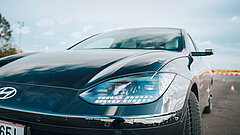
The front bumper
The front bumper features side air inlets, known as air curtains. These not only give the car a distinctive character, but also guide the airflow through channels into the wheel arches, thus ensuring less aerodynamic drag.
At the front, the bumper also has two air flaps that you can open or close depending on the driving conditions and which also have a positive effect on the vehicle's efficiency.
The bonnet
By the way, a frunk is hidden under the bonnet, which is relatively small with a volume of approx. 14.5 litres. Nevertheless, it offers space for your loading equipment, for instance.
The dimensions of the Hyundai IONIQ 6
At 4.86 metres, the vehicle is relatively long. The large wheelbase of 2.95 metres ensures plenty of legroom in the car, even for tall passengers. The length is perhaps less ideal for handling in the city, but in terms of interior space, it is of course great and no big deal for experienced drivers. Our Hyundai IONIQ 6 is also 1.88 m wide, 1.50 m high and weighs around 2 tonnes.
The exterior mirrors
This vehicle has digital exterior mirrors with integrated indicators as an optional extra. They are electrically adjustable and heated. That's a fantastic feature, especially in winter. The digital mirrors serve as a camera. There are monitors in the interior that replace the conventional exterior mirrors. We'll come back to this later.
The digital mirrors are also intended to improve aerodynamic drag and thus the range.
The door handles and the door lock
With its recessed door handles, the Hyundai IONIQ 6 is somewhat reminiscent of the Tesla Model X. However, we are already familiar with these handles from the IONIQ 5, where the pixel element is once again used as an application.
The keyhole is hidden behind the door handle, allowing the door to be unlocked manually if, for some relatively unlikely reason, the automatic door release does not work.
The rear
For aerodynamic reasons, the rear window is pulled downwards considerably. Unfortunately, this is not always ideal for the people in the back seat. The rear spoiler with winglets increases downforce and the lightweight boat tail structure reduces drag to maximise the electric range. Below this spoiler you can see a beautiful strip of pixel lights that runs from right to left. And underneath, there are also further aerodynamic elements, namely two diffusers.
The boot
The boot of the Hyundai IONIQ 6 has a capacity of around 400 litres. If you fold down the rear seat, you can expand the boot to up to 760 litres. Very impressive for a saloon, in our opinion.
The charging capacity of the Hyundai IONIQ 6
The charging socket with a Type 2 and a CCS charging connection is located on the right-hand side of the car at the rear.
DC charging power
Thanks to the 800-volt charging technology and the maximum charging power of over 220 kW DC, the IONIQ 6 is one of the cars that can charge the fastest.
In just 18 minutes, you can charge it from 10 to 80% at an HPC charging station, or the IONIQ 6 can recharge to a range of 100 kilometres in around 5 minutes. 20 minutes for 400 kilometres, which means you’re not going to spend a lot of time at the charging station.
AC charging power
At an AC charging station, such as the go-e Charger, the IONIQ 6 enables a maximum charging capacity of 11 kW. This means you can charge from 0 to 100% in around 7 to 8 hours at a public AC charging station or a wallbox such as the go-e Charger. After a good night's sleep or a day at work, you can theoretically drive more than 500 kilometres again in optimum conditions, depending on the weather, driving style and road.
The vehicle-to-load function of the Hyundai IONIQ 6
The car offers a very forward-looking vehicle-to-load function and thus already points the way to bidirectional charging.
Simply plug the Vehicle-to-Load adapter into the car's charging socket and you can use it to charge or directly power various electrical devices. This means you can be autonomous when you're out and about if there is no power source to be found. This is also a useful function when camping.
Please note that the adapter is included with our model, but must otherwise be purchased as an optional extra.
Inside the car, under the rear seats, you can also use the vehicle-to-load function via a 230-volt socket.
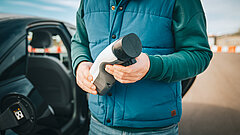

The interior of the Hyundai IONIQ 6: The rear seat
The interior is kept very clean. Our Hyundai IONIQ 6 is equipped with light-coloured leather seats and heated front and rear seats.
You and your passengers have plenty of legroom in the rear seat thanks to the long wheelbase. It is a pity that, as briefly mentioned earlier, you don't necessarily have much space upwards. If you're taller than 1.80, you'll have to tilt your head in a little due to the relatively flat rear window.
The floor in the rear is flat and not divided in the centre by a raised section, which offers additional space. The rear seat also has a relatively large armrest.
There is also a power socket under the rear seat and a USB-C port and air vents at the rear end of the centre console.
Unfortunately, the storage compartments in the doors offer relatively little space to store things, as Hyundai has designed the doors to be somewhat slimmer. However, this helps with regard to the electric range. Keys and other small items fit in, but it becomes more difficult with a larger water bottle, for example.
The interior of the Hyundai IONIQ 6: The cockpit
The cockpit also has a very clean and modern design. The interior is finished in hard plastic. The environmentally friendly and high-quality choice of materials is quite exciting. Depending on the trim level, the seats are made from eco-leather or recycled PET plastic yarn, for example. Recycled fishing nets are used in the carpets. These are just two of many indicators of Hyundai's commitment to a more responsible approach to the environment.
The doors of this model have an integrated Bose premium sound system. The glove compartment of the Hyundai IONIQ 6 is integrated as a drawer rather than a hinged compartment and therefore offers a lot more space.
The Hyundai IONIQ 6 is equipped with seven airbags, which are located at the front, sides and rear of the centre console.
The centre console offers plenty of storage space. It has two cup holders, a small compartment in which you can store your keys or other small items and another large and small compartment at the rear, which conceals two USB-C ports. The window controls in the Hyundai IONIQ 6 are also located in the centre console, making them easily accessible for front passengers.
The front seats are electrically adjustable on the side of the seats. In our case, they are even equipped with a reclining function. So when you charge your car, you can also recharge your batteries at the touch of a button.
Highlight: The ambient lighting
Our Hyundai IONIQ 6 also has beautiful ambient lighting as an optional extra. You can adjust the desired colour in the settings on the display. A great feature and the icing on the cake, in our opinion.
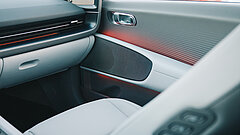
Operating the Hyundai IONIQ 6
Now let's take a look at the operation.
The steering wheel
The steering wheel is made of leather and sits comfortably in the hand. It is flattened at the bottom. Depending on the equipment, the steering wheel has interactive pixel lights in the centre that provide information about the driving mode, charging status and other things. A nice feature, but at extra cost.
A number of levers and buttons are arranged around the steering wheel, which are very easy to reach and pleasant to the touch. Please note: the gear shift button on the Hyundai IONIQ 6 is located at the bottom behind the steering wheel. This may take some getting used to, but after just a few journeys it becomes completely normal.
We find it really convenient that you can set the driving modes (ECO mode, normal mode or sport mode) at the touch of a button.
The instrument display
The Hyundai IONIQ 6 has an integrated 12.25-inch instrument display and a 12.25-inch infotainment system with touch function, which displays beautiful effects on start-up.
The menu here is equipped with large icons. On the start screen, you can already see the current charge level of the battery and the expected range based on the previous driving style. Swiping to the right takes you to the apps and the individual settings.
The air conditioning
You can control the climate control both via the touch display and via the buttons below. We think it's good that Hyundai offers different ways for different customer groups.
The radio
We also find the analogue button for adjusting the volume of the radio important and correctly placed. If you had to look for this on the display while driving, it could be dangerous.
The infotainment system
Energy info
You can find the energy information for the charging processes in the settings. For DC charging, for example, it only makes sense to set up to 80 %. You could also set 90 %, as the car often charges so quickly at HPC charging points that it is already finished when you return.
Safety functions
In the settings, you can of course also adapt various safety functions, such as the lane departure warning system. We'll give you a little tip on this later during the journey.
Charge planning via the navigation system
Charge planning via the navigation system, which you can use via the voice assistant, is certainly also exciting. To do this, either click on "Navigation" in the display or press the "NAV" button on the climate control display. If your charge level is not sufficient for the selected route, you will automatically be shown suitable charging stations on the route so that you know where you can charge your IONIQ 6 on the way to your destination.
In the navigation settings, you can of course specify in advance which type of charging station you would like to use, i.e. AC, DC, HPC. It is also possible to select the provider if you prefer a specific provider. Please note that the automatic route planning sometimes only selects the charging stations that are available live. It is therefore possible that an occupied charging station is not shown, even though you will not reach it for another three hours and it may then be free.
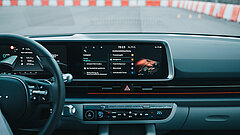
Warning function when speeding
One major disruptive factor in the Hyundai IONIQ 6 is certainly the warning function for exceeding the speed limit, even if it's only by 1 km/h. This is the beeping that you will hear in the car depending on how you drive. This function is prescribed by the EU, so Hyundai can do little about it. But what the manufacturer could have done much better here is to make it easier to switch off this warning function. It's pretty well hidden in the settings, so you'll need some time to switch off the beeping.
Of course, you should always stick to the speed limit, but it's happened to all of us that the speedometer accidentally shows 1 or 2 km/h too much, right?
Apart from that little nuance, the equipment and handling of the Hyundai IONIQ 6 are top notch. And perhaps there will be a software update that will make this much easier.
The Hyundai IONIQ 6 on the road
The Hyundai IONIQ 6 drives very smoothly. On asphalt, the vehicle offers stable road holding. It is safe and pleasant to drive, regardless of whether you have to turn in quickly or take one or two tight bends. The vehicle feels highly agile. The smooth steering is also pleasant. You don't feel any bounce here. There is a slight understeer, yes, but only when you are travelling at really high speeds. Otherwise, the driving experience with the Hyundai IONIQ 6 is excellent.
The turning circle of the car is relatively large at around 12.5 metres, which is not necessarily ideal, especially in the city. But well, turning and parking is a matter of practice for every car. We'll discuss parking a little later. Now we will also introduce some functions and settings.
Functions and settings
Instrument display
We could see all the important information on the instrument display. For instance, the current charge level of the battery, the recuperation level set, the outside temperature, whether the lights are on or not and the current fuel consumption. We can also see, for example, the current speed and predicted range, which assistance systems are activated and which speed limit applies at the current location.
Exterior mirrors
As already mentioned, our model has digital exterior mirrors that project the exterior view into the interior with pin-sharp clarity. For many drivers, this will certainly take some getting used to at first, but you will get used to it over time. If you buy the basic version of the Hyundai IONIQ 6, you will drive with the standard exterior mirrors.
AutoHold
The Hyundai IONIQ 6 has a button called AutoHold. This is very practical, because as soon as you press the brake and the car has come to a standstill, you can release the brake again, for example when you are at traffic lights. You don't have to switch to parking mode and the car doesn't move again until you accelerate.
Cruise control
The cruise control button is on the left-hand side of the steering wheel, and you can also adjust the speed directly below it while driving. Depending on the setting, the speed is also automatically adjusted to the current speed limit, provided the signs are recognised correctly or the right speed limit is stored in the navigation system. When using cruise control, you can also adapt the distance to the car in front of you, which is automatically maintained by the Hyundai IONIQ 6 by adjusting the speed. This means you need to select it depending on whether you prefer to keep more or less distance.
Paddle shifters
What we also find quite ingenious: With the shift paddles on the right and left behind the steering wheel, you can even adjust the recuperation while driving. This allows you to influence how hard the car brakes automatically when you accelerate less or not at all. The higher the level, the more energy is fed back into the battery.
Lane keeping assistant
Next to the cruise control, you will find the button for the lane departure warning system. We find the assistant, which is switched on as standard according to EU regulations, a little too tight, as it actually gives you the option of driving out of your lane. In this case, the car beeps first, but sometimes guides you back into the lane ad hoc and far too hard to the right.
You can switch it off with a long press on the button. The corresponding display then goes out in the instrument display. If you press the button briefly, another lane departure warning system is activated, which keeps you perfectly in your lane based on the lane markings. This assistant is also shown at the top of the display. There is almost no need to steer with this one when you are travelling freely. The following applies to both lane departure warning systems: if the symbols in the instrument display light up green, they are actually active.
Additional safety assistants
In addition to Lane Keeping Assist, this Hyundai IONIQ 6 also has many other safety assistants, such as Blind Spot Assist, Emergency Brake Assist and Exit Assist, which warns you before you open the door if a cyclist or pedestrian approaches from behind.
Head-up Display
Our IONIQ 6 also has a head-up display that shows you the most important information, such as the current driving speed and general speed limits.
The range of the Hyundai IONIQ 6
According to the manufacturer, the IONIQ 6 has a combined range of 614 kilometres WLTP in the best case, a consumption of 13.9 to 15.1 kWh/100 km depending on the equipment variant and accelerates from 0 to 100 km/h in 7.4 seconds in the best case, according to Hyundai.
The Top Speed and Braking Distance of the IONIQ 6
According to ADAC, its stopping distance from 100 km/h is 35.5 metres. It can reach a top speed of 185 km/h. Then it is locked. We believe this totally makes sense because fuel consumption increases disproportionately at high speeds anyway.
When overtaking, the vehicle needs 3.6 seconds from 60 to 100 km/h according to the ADAC. Our team loves this lively driving style. If you're rather cautious when overtaking, you can pass any lorry with ease.
Parking with the Hyundai IONIQ 6
Parking beepers at the front and rear and the reversing camera help you to park. In addition, our Hyundai IONIQ 6 is equipped with a 360-degree overview camera. This works very well and makes parking much easier. In the setting, you can see the wheel rims, for example. If you park close to the curb, this is certainly an advantage. Our vehicle also has a parking assistant for intelligent parking, which makes the whole thing child's play.
The Hyundai IONIQ 6: Conclusions
Summary
We were highly impressed by the Hyundai IONIQ 6, except for the beeping when exceeding the speed limit—an aspect Hyundai should address for easier deactivation. Leaving that aside, the car stands out with its dynamic and efficient design. The innovative and eco-friendly interior materials further contribute to its appeal.
Notably spacious and thoughtfully designed, the IONIQ 6 offers excellent legroom in all seats, though very tall people might find the rear headroom slightly constrained. The driving experience is superb, characterised by safety, comfort, and liveliness. With a remarkable drag coefficient of 0.21, the vehicle comes with exceptional energy efficiency, translating to low power consumption and an impressive electric range. The car charges extremely quickly at DC and HPC charging points and is certainly one of the fastest charging electric cars. In summary, a nearly perfect choice!
